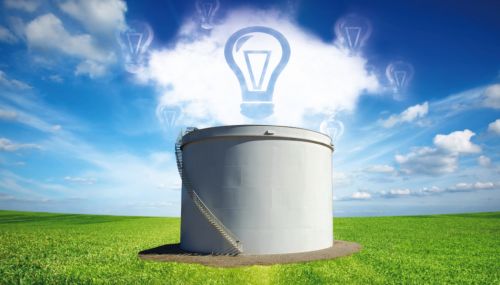All
The Bridge Is Over
by Samuel Diamond

Policymakers and industrialists have long touted natural gas as a “bridge” fuel, one that could help America transition its power generation from fossil fuels like coal to renewable energy sources like wind and solar, lowering carbon emissions along the way. And to an extent, this is happening.
The Power Sector Carbon Index created by researchers at Carnegie Mellon University shows that the retirement of coal and corresponding introduction of natural gas power have helped reduce carbon dioxide (CO2) emissions by 27% since 2005.
However, other discoveries have been made along the way, which reveal that natural gas is not quite the environmentally friendly energy solution proponents have claimed it to be.
First off, there’s the global warming potential (GWP) of natural gas’s primary component, methane, which scientists agree is 84 to 87 times higher than the GWP of CO2 over a 20-year period and about 100 times greater when both chemicals are present in the atmosphere.
Then came the famous Markey findings that gas distribution companies released approximately 69 billion cubic feet of natural gas in 2011 due to old, poorly maintained and faulty transmission lines. “America Pays for Gas Leaks,” a report prepared for Sen. Edward J. Markey (D-MA), estimated that “consumers paid at least $20 billion from 2000-2011 for gas that was unaccounted for and never used.”
Now, the journal Science reports that the U.S. Environmental Protection Agency (EPA) might have been low-balling its emissions stats all along, as recent studies by researchers from across the country reveal that methane leaks represent 2.3% of total natural gas production nationwide — 60% greater than EPA’s estimated 1.4%.
This means that natural gas actually warms the planet as much as coal does over a 20-year period. Which begs the question, “How can something be a bridge fuel if it’s no less dirty than coal?” Where once it appeared there might be cracks in the bridge, it is now clear that the very foundation of the bridge has been taken out from under it.
Oversights & Underestimates
Why is there such a big difference between the old estimates and new findings? How could the EPA have so grossly underestimated natural gas emissions?
It all comes down to data, specifically the amount available, how it’s collected and from where.
The authors of the new report state, “We believe the reason for such large divergence is that sampling methods underlying conventional inventories underestimate total emissions because they miss high emissions caused by abnormal operating conditions.” In other words, previous EPA analyses operated under the assumption that natural gas production facilities leaked a base amount of methane, but the actual amount leaked is probably much higher, especially at certain sites.
Science writes of the new emission-measurement techniques: “Using infrared cameras, an airplane survey of 8,000 industry sites found that 4% had unusually high methane emissions, most tied to hatches and vents in natural gas storage tanks at extraction wells. Thought to be caused by malfunctions, the leaks are rare enough that they are easily missed in most surveys.”
Dr. Steve Hamburg, a lead author of the study and chief scientist with the Environmental Defense Fund, says, “We have so much more data than the EPA does at this point, this is just not comparable.”
The report goes on to confirm the economic impacts estimated by the Markey study. “Natural gas losses are a waste of a limited natural resource (~$2 billion/y), increase global levels of surface ozone pollution, and significantly erode the potential climate benefits of natural gas use,” the new study states.
However, unlike the Markey report, the new study doesn’t take into consideration local leaks and emissions. “Our assessment does not update emissions from local distribution and end use of natural gas, due to insufficient information addressing this portion of the supply chain,” the study states. “However, recent studies suggest that local distribution emissions are significant, exceeding the current inventory estimate, and that end-user emissions might also be important.”
In other words, the actual total methane emissions caused by natural gas use are probably even greater than the new study shows. “The closer we look, the more often we find emissions being higher,” says Rob Jackson, an environmental scientist at Stanford University who has studied natural gas pipeline leaks in Boston and Washington, D.C.
Look Closer, See More
Scientists say that if methane emissions were found at levels equal to 4% of total natural gas production, they would actually be more harmful than coal emissions. The researchers involved in the new study do not see this being the case now, but then again, they acknowledge that their analysis “does not include losses downstream of customer meters due to leaks or incomplete combustion.”
The study’s supplementary materials reveal that “an additional 5 Tg CH4 [teragrams of methane] would be emitted relative to the 0.4 Tg CH4 reported … if 2% of the natural gas delivered to residential, commercial, and industrial consumers in the U.S. were, in fact, emitted — an increase of more than 35% in the national supply chain emissions estimated in this work.” Essentially, this means that if the percentage of methane released downstream is even close to that which is released upstream, then the total methane emissions from the supply chain would be more than 35% higher than even the new study shows.
Furthermore, one author referenced by the study, Robert W. Howarth of Cornell University, has written that “significant quantities of methane are emitted into the atmosphere from shale gas development: an estimated 12% of total production considered over the full life cycle from well to delivery to consumers.” He continues: “When methane emissions are included, the greenhouse gas footprint of shale gas is significantly larger than that of conventional natural gas, coal, and oil.”
Perhaps most revealing of all, the new study acknowledges that because emissions analyses are conducted with the cooperation of participating facilities, they could provide an inherently biased and favorable view not only of those facilities but also of the overall industry. “Operator cooperation is required to obtain site access for emission measurements,” the report states. “Operators with lower-emitting sites are plausibly more likely to cooperate in such studies, and workers are likely to be more careful to avoid errors or fix problems when measurement teams are on site or about to arrive.”
So, if this study only shows part of the overall methane-emissions picture — and of this part, only that which the natural gas industry is willing to show — the question can’t be are things worse than we thought. We now know that, yes, they are. The question now has to be just how much worse, and moreover, how much longer can policymakers continue to present natural gas as a dependable bridge to a cleaner future when the bridge itself has all but collapsed.
Related Posts
 Reflecting on an Incredibly Successful 2025
Reflecting on an Incredibly Successful 2025
Posted on December 31, 2025
 Thinking about Onsite Storage? Start Here.
Thinking about Onsite Storage? Start Here.
Posted on December 23, 2025
 Jim Collura’s First Year as NEFI President and CEO
Jim Collura’s First Year as NEFI President and CEO
Posted on December 22, 2025
 NEFI-Backed National Energy Choice Legislation Advances
NEFI-Backed National Energy Choice Legislation Advances
Posted on December 22, 2025
Enter your email to receive important news and article updates.
